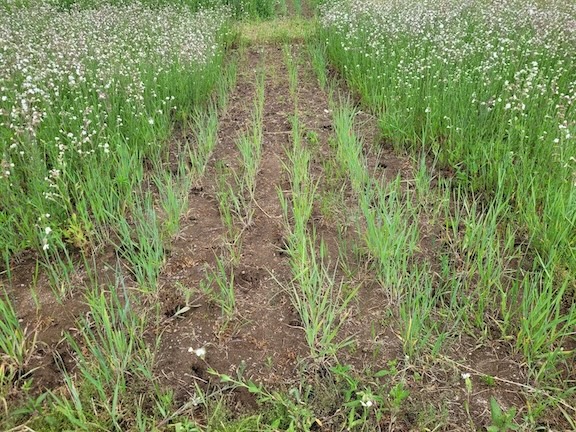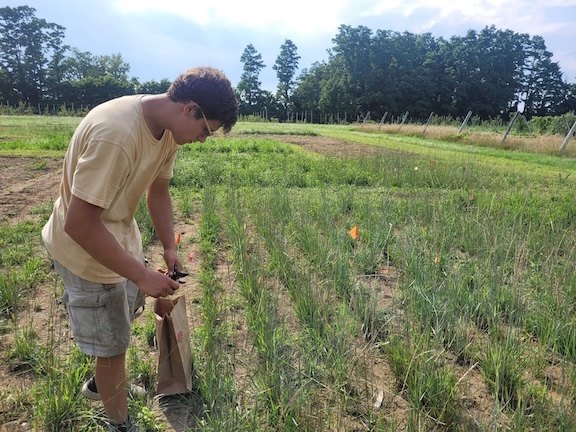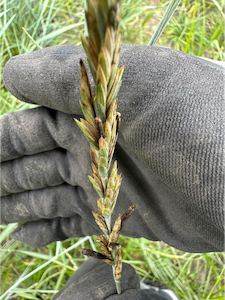By Kevin Haggerty and Eric von Wettberg
Have you ever heard of perennial wheat? As the ecological impacts of some annual farming systems become better understood alongside the growing need to adapt to climate change, new approaches to producing grains are gaining significance. One such approach to building resilience is through adopting new crops well suited to weather variability and capable of repairing damage done to agroecosystems from past production. A result of these efforts is kernza, the first commercially available perennial grain crop.
Kernza is an improved and trademarked variety of indeterminate wheatgrass, Thinopyrum intermedium, developed through a collaborative breeding program involving The Land Institute, the University of Minnesota and the Rodale Institute. Spurred by concerns over erosion, water degradation and a changing climate, kernza was bred with the goal of creating a productive grain that does not require seasonal replanting, develops robust root systems and thrives in diverse ecological communities. The domestication of kernza has primarily focused on improving traits ideal for agricultural cultivation, while not inhibiting the perennial nature and conservation potential of the crop.
Though kernza is actively in development, its commercial production is spreading quickly. As interest in kernza transitions from specialty bakers to companies like Patagonia and General Mills adding kernza-based offerings to their product lines, excitement over its regenerative potential to change the grain industry has clearly reached the mainstream.
Potential and Limitations
This excitement is not unfounded. Central to kernza’s promise of increasing the sustainability of grain production is its expansive root system. With roots extending up to 10 feet deep into the soil, kernza has the potential to greatly improve soil structure and prevent soil erosion common in agriculture. Through its root system, kernza offers the potential to mitigate the effects of climate change by sequestering atmospheric carbon and storing it deeply underground in stable forms of soil organic matter protected from the regular tillage of annual production systems.

Kernza also offers an array of ecosystem services. Providing perennial ground cover, fields of kernza present valuable habitat for wildlife. Below the soil, kernza’s continuously living root system retains soil nitrate effectively, reducing nutrient leaching from agricultural operations into waterways. Finally, this unique root structure can utilize water stores in deep soil layers, adding to kernza’s resilience under high levels of evaporative stress and drought events.
Despite these exciting ecological benefits, kernza does have serious agronomic limitations. The most obvious of which is its low grain yields. Improving yields is a priority of kernza’s ongoing selection, but at the moment kernza consistently yields a fraction of what would be expected of annual wheat. Furthermore, as plantings age, grain yields have been seen to consistently decrease from season to season, most likely due to inter-row competition and lodging. This disparity in harvestable grain is not surprising for a fairly new crop, but it poses a serious challenge to the scalability and profitability of kernza grain production.
Regardless, farmers are adopting kernza. One approach early adopters are employing to mitigate the economic impacts of kernza’s poor grain yields is to manage it as a dual-purpose forage and grain crop. Other growers highlight kernza’s ability to stabilize sloped land, regenerate exhausted soils, reduce fertilizer needs, and break disease cycles as driving factors for adding kernza to their rotations.
Experiences with Kernza in New England
Though the majority of kernza’s production is in conventional grain-growing regions, a handful of folks are exploring kernza’s potential as a viable conservation-focused crop in northern New England. At the University of Vermont (UVM), we planted a small trial of kernza in the fall of 2021 as part of the New Roots for Restoration NSF Biology Integration Institute, in partnership with the Danforth Center, The Land Institute and other partners. We interplanted alfalfa into parts of this trial, to look at the potential of co-planting a perennial cereal and hay crop. Over the course of the following two growing seasons, a few key initial observations relating to kernza in this climate were made.

First, establishing kernza can prove challenging. After its initial planting, half of the UVM plot required replanting due to poor germination and high weed pressure, highlighting kernza’s sensitivity during its establishment period. To help stands become successfully established, care should be taken to ensure kernza is planted at the appropriate shallow depth, receives adequate precipitation after seeding, and that the weed pressure in selected sites has been proactively managed prior to planting. Beyond this, weed management is a challenge for kernza production especially in a climate that receives regular summer precipitation. In our experience, kernza did not outcompete tenacious annual weeds, instead requiring ongoing cultivation throughout the first two seasons. New England growers should not expect to “set and forget” kernza; instead, ongoing management should be top of mind, and tools like tine weeders and rotary hoes should be used early and often. We have not observed significant insect damage but have noted some signs of smut on seed heads.
Down the road from the UVM horticulture farm is Meach Cove Farms, which planted 8 acres of kernza in 2018. At both Meach Cove and UVM, harvested grain yields were far lower than those of annual wheat. After its fifth season, the kernza at Meach Cove is also demonstrating yield declines expected of mature stands. Grain yields at UVM from plots co-planted with alfalfa have been seen to be lower than those not interplanted. Despite this, interplanting kernza with alfalfa may improve overall forage production and help compensate for the decreased grain yield. With this in mind, future research to understand appropriate techniques for maintaining sustained grain production is valuable, as is intentional grain testing to better understand the quality of kernza grown in New England.
Considerations for Interested Growers
For those interested in pursuing kernza production, a few key considerations can help lead to success. First, there is the unique process for sourcing seed. Kernza is currently trademarked by The Land Institute and protected through an Identity Preservation Program. To access seeds, interested growers must become licensed by filling out an application at kernza.org. Once licensed, when selecting seeds, it is important to choose the most improved varieties correct for your growing climate. Of the six varieties available, only one, MN-Clearwater, is better suited for the wet springs and precipitation of the Northeast. Because of this, interested growers in New England should consider planting MN-Clearwater over other available varieties.
When it comes to site selection, it is important to remember that kernza does not thrive in waterlogged, wet soils. When choosing sites, avoid fields that are low lying, prone to flooding, and have heavy clay soil profiles. As seen at UVM, weeds can inhibit establishing viable kernza stands. Prioritize fields with low levels of perennial weeds and limited pressure from cool-season grasses. Timing tillage, the use of the stale seed bed technique, and seedbed preparation to reduce the weed seedbank is also important for successful stand establishment.

In the Northeast, plant kernza prior to September 15, to ensure ample growing degree days for adequate growth prior to winter. Kernza should be seeded shallowly at a rate of 10-18 pounds per acre. Most producers seed kernza in rows 6 to 8 inches apart; however, growers interested in maintaining sustained production may consider wider spacings to reduce the risk of inter-row competition and lodging.
Kernza does not ripen uniformly, instead maturing from the tops of the seed head downwards. For this reason, kernza should be harvested when seed heads arch over and at the first observation of seeds on the ground. Waiting too long can result in seed head shattering and reduced yields. Harvest can be performed by hand, swathing, or direct cutting with a combine, aiming for moisture levels less than 15% at time of harvest. For those interested in managing kernza as a dual-use crop, grazing, harvesting of straw and forage cutting is recommended after grain harvest so as to not impact seed yields.
Final Thoughts and Resources
Kernza’s ongoing development is happening rapidly with continued improvement to yields, seed size and ideal ripening characteristics. As seed and infrastructure availability grows, along with a technical knowledge base for production and processing, markets and supply chains for kernza are expected to increase as well. We are excited to watch this development progress along with a regional understanding of kernza’s potential in New England. To stay up to date on kernza and to explore the detailed growing guides and resources available to interested growers, visit kernza.org.
Kevin Haggerty is a graduate student in the food systems program at the University of Vermont. Eric von Wettberg is the director of the Vermont Agricultural Experiment Station and a professor in the department of plant and soil science at the University of Vermont. Both are happy to field any question about kernza and perennial grains, although they often have to find answers elsewhere. You can contact them at [email protected] and [email protected].
This article was originally published in the summer 2024 issue of The Maine Organic Farmer & Gardener. Browse the archives for free content on organic agriculture and sustainable living practices. Subscribe to the publication by becoming a member!
